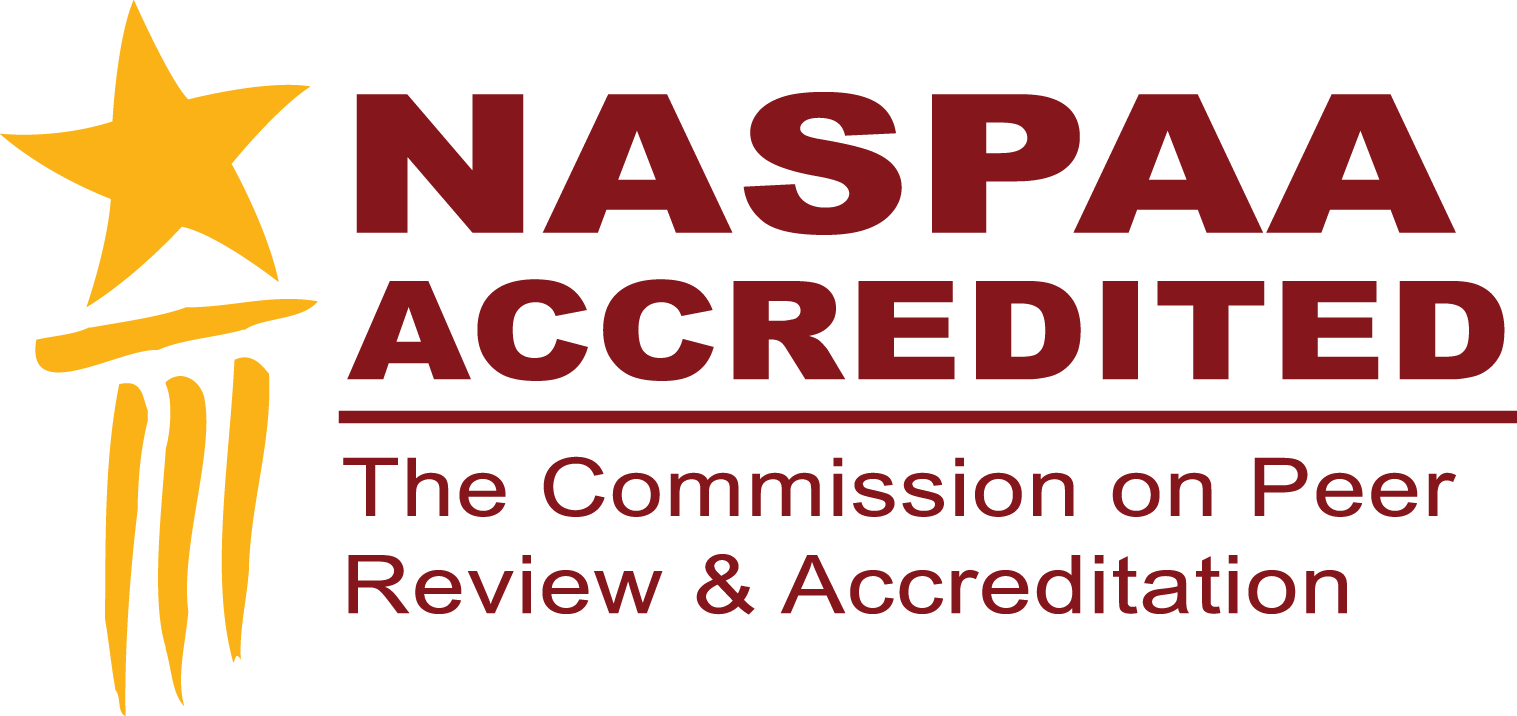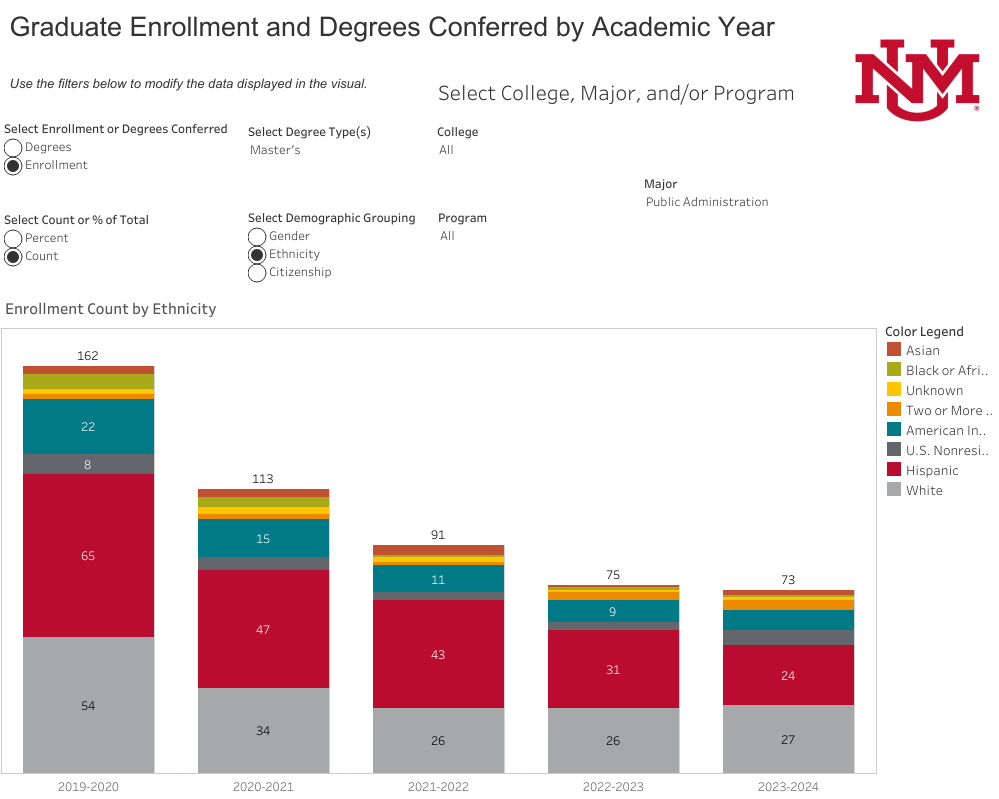Master of Public Administration (MPA)

The master’s degree program in Public Administration (MPA) at the University of New Mexico was established in 1969 and is accredited by the Network of Schools of Public Policy, Affairs, and Administration (NASPAA). The program is proud to serve a highly diverse student body. The School of Public Administration has the highest percentage of minority students of any graduate degree program at the University of New Mexico.
Mission Statement
The MPA Program prepares current and future leaders in public, nonprofit, and tribal sectors through high-quality education that fosters collaboration, inclusivity, and adaptability. The program focuses on developing essential leadership and governance skills, grounded in ethical principles and professional competencies.
Program Goals
- Advancing a curriculum based on ethical principles, critical functions, and professional skills with a focus on strategic planning and inclusivity.
- Engaging with technologies and organizational resources.
- Pursuing complementary research and transforming learning into actions that serve our communities.
- Providing a framework of diversity, equity, inclusion, justice, and accessibility for the necessary skills and competencies required to tackle complex public issues.
Course Formats
To accommodate mid-career professionals, all our classes are offered in the evening and on Saturdays. Students can complete the program face-to-face and via Zoom.
Program Outcomes
Number of MPA Students

| For MPA Students of the Academic Year 2019-2020 Cohort | ||
Enrollment and Graduation | ||
Initially Enrolled | 37 | 37 |
Graduated within 2 years | 11 | 11 |
Graduated within 3 years) | 3 | 14 |
Graduated within 4 years | 7 | 21 |
Graduated within 5 years | 3 | 24 |
Graduated within 6 years | 1 | 25 |
Total Students Graduated | 25 | 25 |
Students of MPA Cohorts Persisting to graduating | 12 | 12 |
The data reported represent students who initially enrolled in the
Time to degree
The MPA program is 42 credit hours required, and the definition of full-time graduate enrollment is 9 or more credit hours per semester. As data shows, students that complete the program as full-time graduate students are extremely rare. Our students are usually employed and the majority work full-time, so they take fewer credit hours per semester than would pre-service students (although the profile of our student body has been gradually shifting to include more pre-service students than in-service students). The recommended pace of steady progress is designed to lead to program completion in three years of part-time study.
Employment and Job Placement | AY 2023-2024 |
National or central government in the same country the program | 1 |
State, provincial, or regional government in the country as the program | 0 |
City, county, or other local government in the country as the program | 3 |
Government not in the same country as the program (all levels) or international quasi-govermental | 0 |
Nonprofit domestically-oriented | 6 |
Nonprofit.NGOs Internationally-oriented | 1 |
Private sector - research/consulting | 3 |
Private sector but not research/consulting | 3 |
Obtaining further education | 0 |
Military Service | 2 |
Unemployed (not seeking employment) | 0 |
Unempolyed (seeking employment) | 0 |
Status unknown | 1 |
Total | 20 |
The data represent students employed in "profession" within 6 months of
graduation (AY 2023-2024).
Learning Assurance Plan
The School is accredited and adheres to the standards of the Network of Schools of Public Policy, Affairs, and Administration (NASPAA) Commission on Peer Review and Accreditation (COPRA). The standards include the following goals for student learning:
NASPAA Standard 5.1 Universal Required Competencies
As the basis for its curriculum, the program will adopt a set of required competencies related to its mission and public service values.
The required competencies will include five domains: the ability...
- to lead and manage in public governance;
- to participate in and contribute to the policy process;
- to analyze, synthesize, think critically, solve problems and make decisions;
- to articulate and apply a public service perspective;
- to communicate and interact productively with a diverse and changing workforce and citizenry.
To achieve competency in each of these five domains, the School specifies six hierarchical categories and 22 components of Student Learning Outcomes (SLO).
UNM MPA Student Learning Outcomes and Associated NASPAA Domains
- MPA graduates will demonstrate knowledge of...
- Organizational behavior (NASPAA 1)
- Human resource management (NASPAA 1)
- Public budgeting and financial management (NASPAA 1)
- Strategic planning and strategic management (NASPAA 1)
- Program evaluation and performance measurement (NASPAA 1 & 2)
- Comparative and case analysis (NASPAA 3)
- Information and network management (NASPAA 3)
- MPA graduates will demonstrate the ability to identify...
- Organizational challenges (NASPAA 3 & 4)
- MPA graduates will analyze policies and programs by applying appropriate...
- Information technology and data management tools (NASPAA 3)
- Quantitative and/or qualitative analysis methods (NASPAA 3)
- Ethical research standards (NASPAA 4 & 5)
- MPA graduates will appropriately and effectively apply...
- Management theory and organizational analysis (NASPAA 1 & 3)
- MPA graduates will demonstrate a nuanced understanding of...
- Public, private, and non-profit sector interactions (NASPAA 4)
- Managing diversity in the global environment (NASPAA 5)
- MPA graduates will demonstrate excellent...
- Verbal communication ability (NASPAA 4 & 5)
- Written (expository and analytical) communication ability (NASPAA 4 & 5)
Methods of SLO Assessment
Direct measures for each SLO component are obtained from embedded core course assessments and associated scoring conventions and from the standardized thesis or capstone project scoring matrix.
The performance target for the current three year period is for 75% of students to achieve satisfactory (basic competence) or better performance on each SLO. Student performance in each required course is sampled one time per year, in either Fall or Spring semester.
Additional Learning Assessment Methods and Measures
Indirect information regarding the achievement of the program’s learning outcomes is obtained using the following measures and methods:
Measures:
- Employment of graduates
- At entry to program
- At graduation
- Three years after graduation
- Time to degree
- % graduating within three years of first enrollment
- % graduating within four years % graduating within seven years
- Perceptions/opinions of curriculum and instruction quality as effective preparation for the knowledge, skills, responsibilities, and values required for students’ employment
- Perceptions/opinions of improvements needed
Methods:
- Enrollment data review
- Course record review (grading patterns, enrollment, completion rates)
- Student evaluations of courses, per university mandate
- Annual faculty meeting devoted to learning outcomes review
- Other faculty meeting discussions
- Annual consultation with Advisory Board or similar community focus group
- Tri-annual surveys of current students, alumni and employers
- Student exit surveys each semester
- Annual faculty performance reviews
- Peer evaluations of teaching
- Self-reflection on teaching
Contact
Graduate Advisement
spadvise@unm.edu
(505) 277-1092
